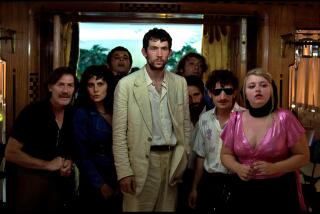‘Horseman on the Roof’ Is Dashing Romance
Jean-Paul Rappeneau’s “The Horseman on the Roof” is a superb example of the classic European period romance, based on the third novel of Jean Giono’s celebrated Stendhal-like Horseman cycle.
It has an impossibly handsome hero and an equally beautiful heroine, takes place against gorgeously photographed landscapes, and moves at a galloping pace accompanied by appropriately tempestuous bursts of music. Above all, it has an all-crucial subtle, contemporary wit, allowing us to take its charismatic protagonists seriously while providing for a bit of tongue-in-cheekery in regard to its gloriously old-fashioned, unbridled derring-do.
Olivier Martinez’s Angelo, a noble colonel in the Piedmontese Hussards, is such a self-confident, fearless and bold swordsman-soldier that his lady-in-distress, Juliette Binoche’s French aristocrat, Pauline de Theus, has to smile at him in amusement. He is in fact so parfit a knight he doesn’t give in even when his liege-lady, which is what Pauline has become, makes a pass at him. Never mind that he’s the first of the two to fall in love.
Angelo is a man with a mission if ever there was one. The time is July 1832; the place is Aix-en-Provence, and we can surmise that all the fireworks are commemorating Bastille Day, the perfect cover for a band of brutal Austrian spies to swoop down upon freedom-fighting Italian patriots, the Carbonari, living in the small city. Many are in exile in France, having fled from the northwest corner of the Italian peninsula, where as revolutionaries they faced persecution by the Austrian Empire’s puppet monarch, Carlo Alberto.
Fleeing Aix, Angelo heads for the picturesque mountain town of Manoesque, a center for Italian exiles--and Jean Giono’s hometown--to warn them of the band of Austrian exterminators heading their way. In doing so he rushes headlong into a raging cholera epidemic that has so terrified the hysterical locals that their immediate impulse is to slay any stranger as a scapegoat for their catastrophe.
The film gets its title from Angelo riding his horse over the tile roofs of the town in his desperate attempt to escape. Ultimately, he takes refuge in a palatial townhouse, deserted except for the exquisite, remarkably calm Pauline, who refuses to explain to Angelo why she has not fled with her aunts, owners of the residence.
*
In very short order, however, Angelo and Pauline are on the run together over the lush Provence terrain, with Angelo obtaining from the Carbonari a saddlebag filled with gold that he is to deliver to fellow revolutionaries in Turin but insisting that he first escort her some distance out of his way to her home, Chateau Theus. Needless to say, their adventure--and their inevitable love for each other--has just begun.
When he was a boy Rappeneau became captivated by “The Horseman on the Roof” shortly after it was published in 1953, and the international success of his 1990 “Cyrano de Bergerac” made it possible to realize his dream of filming the Giono novel, which he adapted to the screen with veterans Nina Companeez and Jean-Claude Carriere (who was Oscar-nominated for his adaptation of “Cyrano”). Rappeneau and his cast and crew bring to “Horseman” the same sweeping passion, fierce intelligence and mature humor that characterized “Cyrano,” also a wondrous period re-creation.
In a role reportedly considered, over the years, for Marlon Brando, Anthony Perkins, Alain Delon and Gerard Philippe, young Olivier Martinez couldn’t be a better, more steadfastly gallant and idealistic Angelo, sexy yet innocent, headstrong yet reflective. Binoche, as the also young but more mature, more worldly but also noble Pauline, is a lovely counterpart to Martinez’s Angelo, whose mother, he says, commanded him “to live recklessly.” Although “Horsemen” is essentially a two-character story, the fleeing couple inevitably have some crucial encounters with others, most notably a peddler, played by the veteran Jean Yanne, who has an anti-cholera elixir he insists won’t work--unless “you pay for it.” There’s also an unbilled cameo by “Cyrano” star Gerard Depardieu.
You should be warned, in regard to young audiences, that Rappeneau rightly contrasts his deliriously romantic adventure against a highly realistic depiction of a cholera epidemic, which moves like wildfire and claims its victims in swift but horrible deaths. On the other hand, Rappeneau sets the stage with sufficient clarity that we don’t have to be up on our post-Napoleonic history, a time when the Austrian Empire rose to greedy dominance, to thoroughly enjoy the captivating “Horseman on the Roof.”
* MPAA rating: R, for a scene of nudity. Times guidelines: It includes realistic scenes of people dying of cholera that are too intense for small children.
(BEGIN TEXT OF INFOBOX / INFOGRAPHIC)
‘The Horseman on the Roof’ (‘Le Hussard sur le Toit’)
Juliette Binoche: Pauline de Theus
Oliver Martinez: Angelo Pardi
Jean Yanne: The Peddler
Claudio Arrendola: Maggionari, the Italian Traitor
A Miramax Zoe presentation of a co-production of Hachette Premiere et Cie/France 2 Cinema/Centre Europeen Cinematographique/Rhone-Alpes with the participation of Canal Plus. Director Jean-Paul Rappeneau. Producer Rene Cleitman. Executive producer Bernard Bouix. Screenplay/Adaptation Rappeneau, Nina Companeez, Jean-Claude Carriere. Cinematographer Thierry Arbogast. Editor Noelle Boisson. Costumes Franca Squarciapino. Music Jean-Claude Petit. Art director Ezio Frigerio. Set designers Jacques Rouxel, Christian Marti. Set decorator Francoise Benoit-Fresco. In French and Italian, with English subtitles. Running time: 1 hour, 57 minutes.
* Exclusively at the Royal, 11523 Santa Monica Blvd., West Los Angeles, (310) 477-5581.
More to Read
Sign up for our Book Club newsletter
Get the latest news, events and more from the Los Angeles Times Book Club, and help us get L.A. reading and talking.
You may occasionally receive promotional content from the Los Angeles Times.





